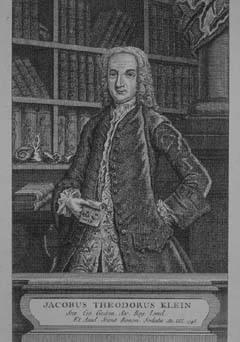Danzig Notables -- Secretär Jacob Theodor Klein

Jacob Theodor Klein was born in Königsberg in 1685, the son of a lawyer at the Prussian court. After studying law, natural history, and history at the university there, in 1706 he began travels through England, Holland, Germany and Austria. In 1713 he became the City Secretary of Danzig. Between 1714 and 1716 he was the city's representative (residierender Sekretär) in Dresden and then Warsaw, returning to Danzig in the entourage of August II, King of Poland and Elector of Saxony in 1716. In 1716, when the Russians sought to impose their inspection of ships at Danzig (against the Swedes), the city sent Klein to Königsberg to argue with Czar Peter the Great. Despite following the Czar to Stettin and Lübeck, Klein's mission was unsuccessful, indeed he was not even granted an audience. He also represented the republic of Danzig in Hanover at the court of George I, King of England.
In 1718 Jacob Theodor Klein acquired a sizeable piece of land in the Langgarten section of Danzig and, with the aid of other scholars and collectors with whom he had become acquainted during his travels, established a notable botanical garden there. It also housed some live animals. Soon he built a building for his Naturalienkabinett (Cabinet of Curiosities), and his collection eventually expanded into what became known as the "Museum Kleinianum" with different rooms for zoological (stuffed, dried and bottled specimens) and mineralogical (amber, fossils and shells) exhibitions as well as a greenhouse for experiments with exotic plants. (Braun assumes that this is pictured on the title page of Klein's Historiae avium prodromus.) When Christian Gabriel Fischer fled to Danzig in 1725, Klein employed him to organize and catalogue his collection. Visitors came to Danzig to visit this museum and garden. Klein presented Crown prince Friedrich of Prussia a blooming coffee tree and the Prince stayed in Klein's home while visiting Danzig in 1740. In that year Klein's collection was sold to the Margrave Friedrich of Brandenburg-Kulmbach. His collection of amber had already been sold to the court in Dresden.
Klein's interest in science had begun as early as 1713, and by 1722 he began publishing on zoology and palentology. Influenced by Johann Philipp Breyne (who in turn followed the examples of John Morton and John Woodward), he was especially interested in the systematical classification of plants and animals. He attempted to order animals according to purely formal and external, easily recognizable criteria. Although this brought him in opposition to the work of Carl von Linné, he enjoyed wide scholarly recognition. He was a member of the Royal Society of London (1729), the Deutsche Gesellschaft in Jena (1748), and the Academy in St. Petersburg (1756). He was a co-founder of the Naturforschende Gesellschaft in Danzig (1743). He died in 1759.
Of particular interest to the biography of Luise Kulmus is the fact that, like the Breyne daughters, Klein's daughters took painting and drawing lessons with the aim of providing illustrations for their father's publications. The most talented of these was Dorothea Juliane Klein. She married another Danzig scientist, Daniel Gralath, who inherited Klein's library. Johann Bernoulli, who saw the library in 1777 or 1778, expressed great admiration for its treasures.
[Armin Geus. Jakob Theodor Klein und seine Vorstellung von einem System der Tiere. In Jahrbuch für Fränkische Landesforschung 30 (1970) 1-13.]
[Hans-Jürgen Kämpfert. Danziger Naturwissenschaftler. Ein Uberblick vom ausgehenden Mittelalter bis zum 19. Jahrhundert. In Danzig in acht Jahrhunderten. Ed. Bernhart Jähnig und Peter Letkemann. Münster: Nicolaus-Copernicus Verlag, 1985. S. 185-211.]
[M. Braun. Jac. Th. Klein's Aviarium prussicum. In Zoologische Annalen. Zeitschrift für Geschichte der Zoologie. II/1 (1906) S. 77-89.]